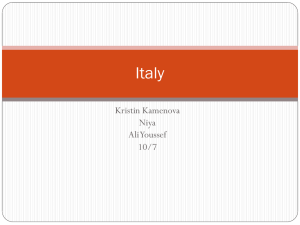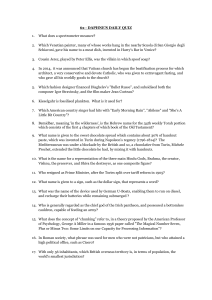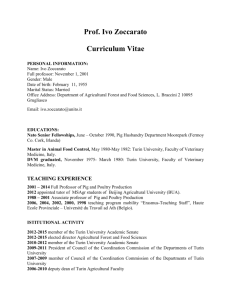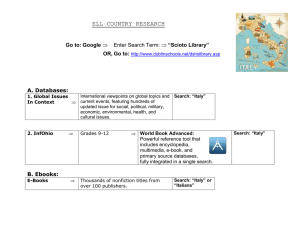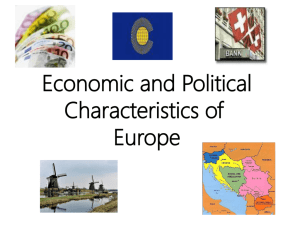A Caution on Precaution – Radio Base Stations and EMF Peter Zollman,
advertisement
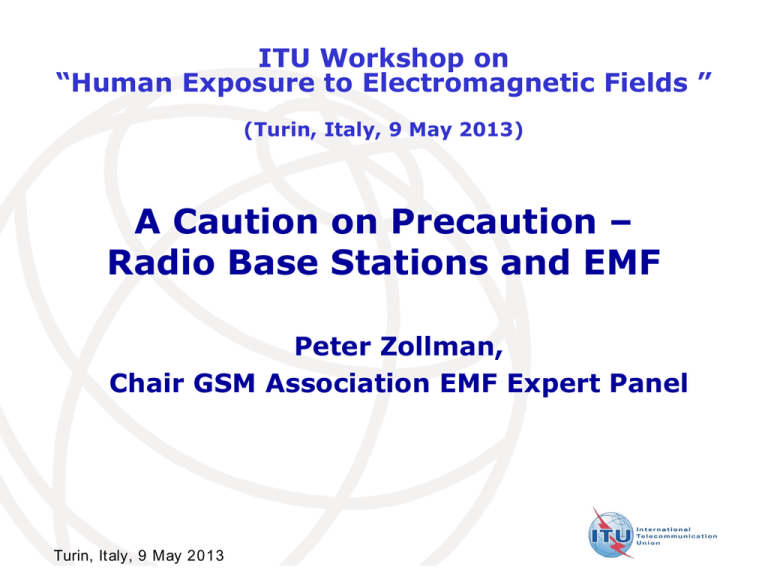
ITU Workshop on “Human Exposure to Electromagnetic Fields ” (Turin, Italy, 9 May 2013) A Caution on Precaution – Radio Base Stations and EMF Peter Zollman, Chair GSM Association EMF Expert Panel Turin, Italy, 9 May 2013 Context Local base stations are needed to support the personal voice/data communications services which provide economic and social benefits Limiting exposure according to ICNIRP recommendations protects all people from proven RF EMF health risks The WHO* and most expert reviewers now consider there is little plausible risk to the general public from base station RF signals However some people remain concerned… *WHO fact sheet No 304, www.who.int/emf 2 Turin, Italy, 9 May 2013 Some people remain concerned Better to have a fence at the top of a cliff rather than an ambulance at the bottom… 3 Turin, Italy, 9 May 2013 Some people remain concerned But if you don’t know if there is a cliff and where it may be... 4 Turin, Italy, 9 May 2013 Some people remain concerned But if you don’t know if there is a cliff and where it may be… Where do you put the fence(s)? 5 Turin, Italy, 9 May 2013 Some people remain concerned But if you don’t know if there is a cliff and where it may be… Where do you put the fence(s)? What is a useful warning? 6 Turin, Italy, 9 May 2013 Some people remain concerned Which landscape is better for your wellbeing? Are the public safer with these fences and warnings? How to judge if a proposed measure is appropriate? 7 Turin, Italy, 9 May 2013 Some cost-benefit criteria European Commission Some cost-benefit criteria ………Examining costs and benefits entails comparing the overall cost to the Community of action and lack of action, in both the short and long term. This is not simply an economic cost-benefit analysis: its scope is much broader, and includes non-economic considerations, such as the efficacy of possible options and their acceptability to the public. Low financial cost? EC COM(2000) 1 Turin, Italy, 9 May 2013 Low environmental impact? Reduces potential health risk? Reduces general public anxiety? 8 Two types of precautionary base station policies Compliance limits lower than ICNIRP* Restricting exposure to base station EMFs to a fraction of ICNIRP recommended public limits WHO says “…Considering the very low exposure levels and research results collected to date, there is no convincing scientific evidence that the weak RF signals from base stations and wireless networks cause adverse health effects.” *Note the EU Recommendation 1999/519/EC is very closely aligned to ICNIRP recommendations for restricting general public exposure so only ICNIRP is referred to here. Planning exclusion zones Prohibiting base stations within arbitrary distances of defined “sensitive” locations (e.g. schools, hospitals..) UK, Health Protection Agency (now Public Health England) says “…there is no scientific basis for establishing minimal distances between base stations and areas of public occupancy… There are many sources of exposure to RF fields, and it would in practice have little impact on people’s overall exposure.” 9 Turin, Italy, 9 May 2013 Compliance limits lower than ICNIRPDoes this reduce potential health risk? No known/anticipated health effect to mitigate so do lower compliance limits reduce general public exposure? Consider simple roof top 3G antenna “The general RF exposure level of the population from the fixed RF sources including LF/MF broadcast, VHF broadcast, UHF TV and telecommunications is very low. The range is between 0,01-1 V/m in Europe that is many times below the exposure limits of EU recommendations.” EFHRAN 2010 10 Turin, Italy, 9 May 2013 Compliance limits lower than ICNIRPdo not mean lower exposure Now apply 1/10 ICNIRP compliance limit without any other change Size of compliance zones increases (reassuring or alarming?) But public exposure remains at the same low level in areas outside these zones where people live and work 11 Turin, Italy, 9 May 2013 Compliance limits lower than ICNIRPdo not mean lower exposure Belgium Netherlands GSM900 limit = 3 V/m GSM900 limit (ICNIRP) = 41 V/m Measured average = 0.93 V/m Measured average = 0.38 V/m 9.6% of Belgium limit Turin, Italy, 9 May 2013 0.01% of ICNIRP limit Joseph et al., 2012. Rowley et al, 2012. 12 Compliance limits lower than ICNIRPCost / Environmental impact? ICNIRP compliance 1/10 ICNIRP compliance Compliance change does not reduce public’s exposure Turin, Italy, 9 May 2013 13 Compliance limits lower than ICNIRPCost / Environmental impact? UK (ICNIRP) Italy (ICNIRP/~40) Compliance increases cost & can make antennas more visible 14 Turin, Italy, 9 May 2013 Compliance limits lower than ICNIRPApplication of criteria Criterion Analysis Effective in reducing potential health risk? No plausible benefit. Does not reduce No exposure. Non-optimum site location may increase handset average power increasing exposure. Reduces general public anxiety? Larger zones feeds non-scientificallysupported fear of base stations. Moving from science-based limits reduces trust in the validity of those limits and public authority’s management of risk. No Low environmental impact? Antennas more visible No Low financial cost? Significant costs to redeploy/redesign sites / unable to offer service No Turin, Italy, 9 May 2013 Met? 15 Planning exclusion zone policies – Case study Melbourne (Australia) - 1 Current policy is ICNIRP limits and no planning-based siting restrictions “What if” case study What % area would become unavailable for base station deployment if prohibited within 500m of pre-schools, schools and hospitals? Publicly available mapping data for community facilities and base station locations 16 Turin, Italy, 9 May 2013 Planning exclusion zone policies – Case study Melbourne (Australia) - 2 Community facility centred If 500m zone applied: across whole urban area would affect >50% of antennas Rises to ~90% in dense urban area Service impacts not directly assessed GSMA report available 17 Turin, Italy, 9 May 2013 Planning exclusion zone policies – Application of criteria Criterion Analysis Met? Effective in reducing potential health risk? No plausible benefit. Nonoptimum site location may increase handset average power increasing exposure where service can be provided No Reduces general public anxiety? Potentially feeds nonscientifically-supported fear of base stations No Low environmental impact? More than 50% sites to be redeployed – where? No Low financial cost? Costs to redeploy sites / unable to offer service No Turin, Italy, 9 May 2013 18 Impact of policies on public concern – Appropriate policy can manage concern UK Strategy International limits National mast policy Code of practice Sample audits Information Research support Turin, Italy, 9 May 2013 MOA, 2012 19 Impact of policies on public concern – Stricter legal safety standards (limits, exclusion zones) 2010 66% - 100% Strong precautionary advice by governments 46% - 65% 31% - 45% 0% - 30% ICNIRP Compliance Communications Data-source: Special Eurobarometer 347, 2010, p. 66; presentation by GSMA Europe Eurobarometer findings 20 Turin, Italy, 9 May 2013 Conclusions ITU should recommend: Applying evidence based EMF exposure limits as advised by the WHO Cooperation with the WHO to clarify scientific uncertainty Having consistent mast policy Be cautious with precautionary measures and avoid policies that are ineffective especially if they create alarm and/or are costly Communicating using trusted health agencies 21 Turin, Italy, 9 May 2013 Thank You Peter Zollman Chair GSMA EMF Expert Panel peter.zollman@vodafone.com Dr Jack Rowley Senior Director Research & Sustainability jrowley@gsma.com Tel: +61 427 070 369 www.gsma.com/health 22 Turin, Italy, 9 May 2013 Slide Short ref Full reference 2, 9 WHO Base stations and wireless networks - Fact Sheet N°304 (May 2006) www.who.int/emf [accessed 17/4/13] 8 EC COM(2000) 1 COMMISSION OF THE EUROPEAN COMMUNITIES, Brussels, 02.02.2000, COM(2000) 1 COMMUNICATION FROM THE COMMISSION, on the precautionary principle http://ec.europa.eu/dgs/health_consumer/library/pub/pub07_en.pdf [accessed17/4/13] 9 Public Health England §53, Documents of the NRPB, Vol 15 No.5 2004 http://www.hpa.org.uk/webc/HPAwebFile/HPAweb_C/1194947333240 [accessed17/4/13] 10 EFHRAN 2010 European Health Risk Assessment Network on Electromagnetic Fields Exposure, Report on the level of exposure (frequency, patterns and modulation) in the European Union, Part 1: Radiofrequency (RF) radiation, http://efhran.polimi.it/docs/D4_Report%20on%20the%20level%20of%20exposure%20in%20the %20European%20Union_Oct2010.pdf [accessed 17/4/13] 12 Joseph et al., 2012. Assessment of RF Exposures from Emerging Wireless Communication Technologies in Different Environments, Joseph et al., Health Physics, 102(2):161-172, February 2012. 12 Rowley et al, 2012. Comparative international analysis of radiofrequency exposure surveys of mobile communication radio base stations, Rowley et al., Journal of Exposure Science and Environmental Epidemiology, 22(3):304–315, May/June 2012. 16-17 GSMA 2012 Prepared for GSMA by Evans Planning, in association with Manidis Roberts and Piconet Consulting, Impact of exclusion zones policies on siting of base stations Australian case study analysis, August 2012. http://www.gsma.com/publicpolicy/wpcontent/uploads/2012/11/GSMA_2012_impact_planning_restriction_network_web.pdf [accessed 17/4/13] 19 MOA 2012 Public Attitudes towards Mobile Phones and Masts, YouGov for the Mobile Operators Association, September 2012. (slide 11) http://www.mobilemastinfo.com/opinion-research/opinionresearch.html [accessed 17/4/13] 20 Eurobarometer 2010 Data from - European Commission, Special Eurobarometer, Electromagnetic fields, June 2010 http://ec.europa.eu/public_opinion/archives/ebs/ebs_347_en.pdf [accessed 17/4/13] 24 IEC 62232 IEC 62232 Edition 1.0 2011-05, Determination of RF field strength and SAR in the vicinity of radiocommunication base stations for the purpose of evaluating human exposure 25 Wiedemann, 2011 How to deal with uncertain risks? The EMF case and beyond, Academy of Disaster Reduction and Emergency Management, Ministry of Civil Affairs & Ministry of Education, The People's Republic of China, Beijing Normal University, 16th of March 2011, Prof. Dr. Peter Wiedemann Turin, Italy, 9 May 2013 Compliance limits lower than ICNIRPSome technical background Field strength falls quickly as you move away from the antenna Lowering the compliance limit affects access-control zones near antenna For typical base station antennas the field falls away more slowly close to the antenna than at larger distances Compliance to lower limits may require site design changes without improving network performance or reducing public exposure 24 Turin, Italy, 9 May 2013 Precautionary Measures = Increased Concern Study conducted in Australia, Brazil, India, Japan, Germany, The Netherlands, South Africa, UK and USA. ICNIRP recommends limits, however, in some countries debate continues. ◄ Less concern More concern ► Base station information Precautionary limits Protect sensitive areas Minimise exposure All precautionary measures increased concern. Turin, Italy, 9 May 2013 Wiedemann, 2011
